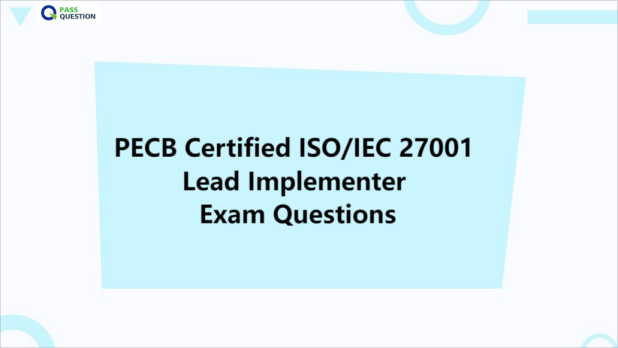PECB Certified ISO/IEC 27001 Lead Implementer Exam Questions
If you want to become an ISO/IEC 27001 Lead Implementer, you must first complete an ISO/IEC 27001 Lead Implementer Certification. This certification process involves rigorous training and assessment to ensure that you have the necessary skills and knowledge to implement an information security management system effectively. Once you have successfully obtained your certification, you will be qualified for lead implementer jobs, which are in high demand in various industries. To assist you in achieving this certification, PassQuestion has newly updated its PECB Certified ISO/IEC 27001 Lead Implementer Exam Questions which are designed to reflect the real exam scenarios, providing you with an authentic practice experience that can significantly improve your chances of passing the exam with ease.

Introduction to ISO/IEC 27001 Lead Implementer
ISO/IEC 27001 specifies the requirements for establishing, implementing, maintaining, and continually improving an information security management system (ISMS). The most important skills required in the market are the ability to effectively plan, implement, and manage the ISMS, assess and treat the information security risks, select and implement the information security controls, and manage (or be part of) ISMS implementation teams.
The “ISO/IEC 27001 Lead Implementer” credential is a professional certification for individuals aiming to demonstrate the competence to implement the information security management system and lead an implementation team. The exam consists of 80 multiple-choice questions, and the passing score is 70%. PECB exams are available in two types: essay-type question exams and multiple-choice question exams.
Who can Attend?
The ISO/IEC 27001 Lead Implementer certification is intended for:
• Managers or consultants involved in and concerned with the implementation of an information security management system in an organization
• Project managers, consultants, or expert advisers seeking to master the implementation of an information security management system
• Individuals responsible for maintaining conformity with the ISO/IEC 27001 requirements in an organization
• Members of an ISMS implementation team
Exam Domains
The content of the exam is divided as follows:
Domain 1: Fundamental principles and concepts of an information security management system
Domain 2: Information security management system requirements
Domain 3: Planning of an ISMS implementation based on ISO/IEC 27001
Domain 4: Implementation of an ISMS based on ISO/IEC 27001
Domain 5: Monitoring and measurement of an ISMS based on ISO/IEC 27001
Domain 6: Continual improvement of an ISMS based on ISO/IEC 27001
Domain 7: Preparation for an ISMS certification audit
View Online PECB Certified ISO/IEC 27001 Lead Implementer Free Questions
1. Which approach should organizations use to implement an ISMS based on ISO/IEC 27001?
A. An approach that is suitable for organization's scope
B. Any approach that enables the ISMS implementation within the 12month period
C. Only the approach provided by the standard
Answer: A
2. Which option below should be addressed in an information security policy?
A. Actions to be performed after an information security incident
B. Legal and regulatory obligations imposed upon the organization
C. The complexity of information security processes and their interactions
Answer: B
3. The ISMS covers all departments within Company XYZ that have access to customers' data. The purpose of the ISMS is to ensure the confidentiality, integrity, and availability of customers' data, and ensure compliance with the applicable regulatory requirements regarding information security."
What does this statement describe?
A. The information systems boundary of the ISMS scope
B. The organizational boundaries of the ISMS scope
C. The physical boundary of the ISMS scope
Answer: B
4. Which of the following is the information security committee responsible for?
A. Ensure smooth running of the ISMS
B. Set annual objectives and the ISMS strategy
C. Treat the nonconformities
Answer: B
5. Why should the security testing processes be defined and implemented in the development life cycle?
A. To protect the production environment and data from compromise by development and test activities
B. To validate if information security requirements are met when applications are deployed to the production environment
C. To Identify organizational assets and define appropriate protection responsibilities
Answer: C
6. The purpose of control 7.2 Physical entry of ISO/IEC 27001 is to ensure only authorized access to, the organization's information and other associated assets occur.
Which action below does NOT fulfill this purpose?
A. Verifying items of equipment containing storage media
B. Using appropriate entry controls
C. Implementing access points
Answer: A
7. Which security controls must be implemented to comply with ISO/IEC 27001?
A. Those designed by the organization only
B. Those included in the risk treatment plan
C. Those listed in Annex A of ISO/IEC 27001, without any exception
Answer: B
8. What is the main purpose of Annex A 7.1 Physical security perimeters of ISO/IEC 27001?
A. To prevent unauthorized physical access, damage, and interference to the organization's information and other associated assets
B. To maintain the confidentiality of information that is accessible by personnel or external parties
C. To ensure access to information and other associated assets is defined and authorized
Answer: A
9. An organization wants to enable the correlation and analysis of security-related events and other recorded data and to support investigations into information security incidents.
Which control should it implement7
A. Use of privileged utility programs
B. Clock synchronization
C. Installation of software on operational systems
Answer: B
10. The incident management process of an organization enables them to prepare for and respond to information security incidents. In addition, the organization has procedures in place for assessing information security events.
According to ISO/IEC 27001, what else must an incident management process include?
A. Processes for using knowledge gained from information security incidents
B. Establishment of two information security incident response teams
C. Processes for handling information security incidents of suppliers as defined in their agreements
Answer: A
- TOP 50 Exam Questions
-
Exam
All copyrights reserved 2025 PassQuestion NETWORK CO.,LIMITED. All Rights Reserved.

